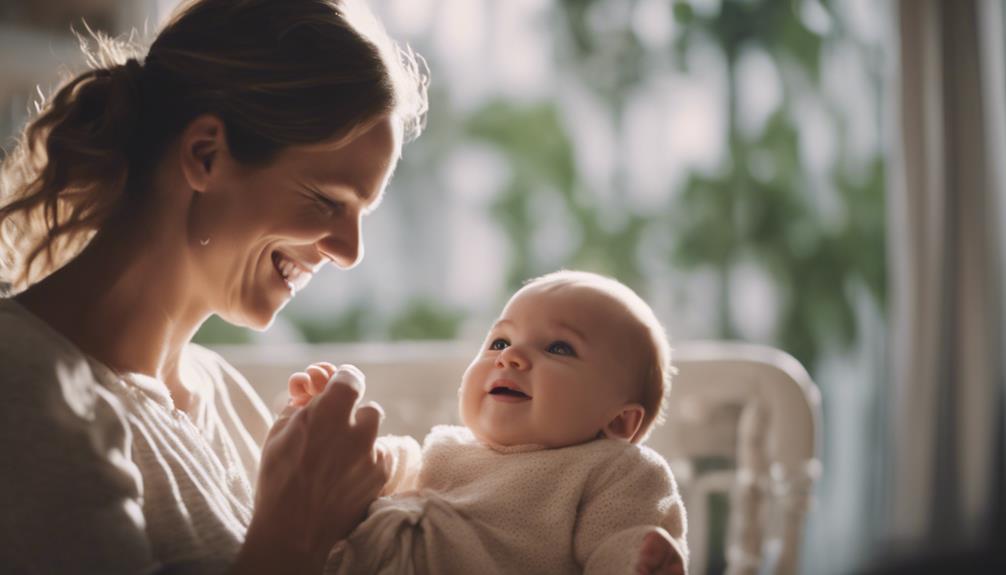Understanding separation anxiety in babies is essential. It typically manifests around 9 months, leading to clinginess, tears, and disrupted sleep. These behaviors are related to establishing a secure bond with primary caregivers. As infants venture out and test boundaries, they crave reassurance and closeness. Separation anxiety can impact attachment and bonding. Genetic and environmental factors play a part in this. Establishing a supportive environment and seeking counseling are ways to address excessive anxiety in children. Offering comfort, sticking to routines, and promoting safe exploration can assist in managing separation concerns. More information on this topic is ready for you to explore.
Key Takeaways
- Separation anxiety emerges around 9 months due to developing attachment and security.
- Babies display clinginess, crying, and disrupted sleep patterns.
- Increased need for reassurance and closeness to caregivers.
- Understanding attachment and fear of abandonment is crucial.
- Families play a key role in managing separation worries.
Normalcy of Separation Anxiety
Significant Separation anxiety is a common and expected part of infant development, typically emerging around 9 months of age. It's a normal phase where babies may display signs of separation anxiety, such as clinginess, crying, and disruptions in sleep patterns during separations from their primary caregivers. This behavior stems from the child's developing sense of security in their attachment figures, as they start to realize that they're separate individuals from their parents.
During this important period of childhood development, infants are also beginning to explore their surroundings and test boundaries, which can lead to an increased need for reassurance and closeness to their caregivers. This process is essential for developing independence and building a strong foundation for future relationships.
Attachment and Excessive Worry
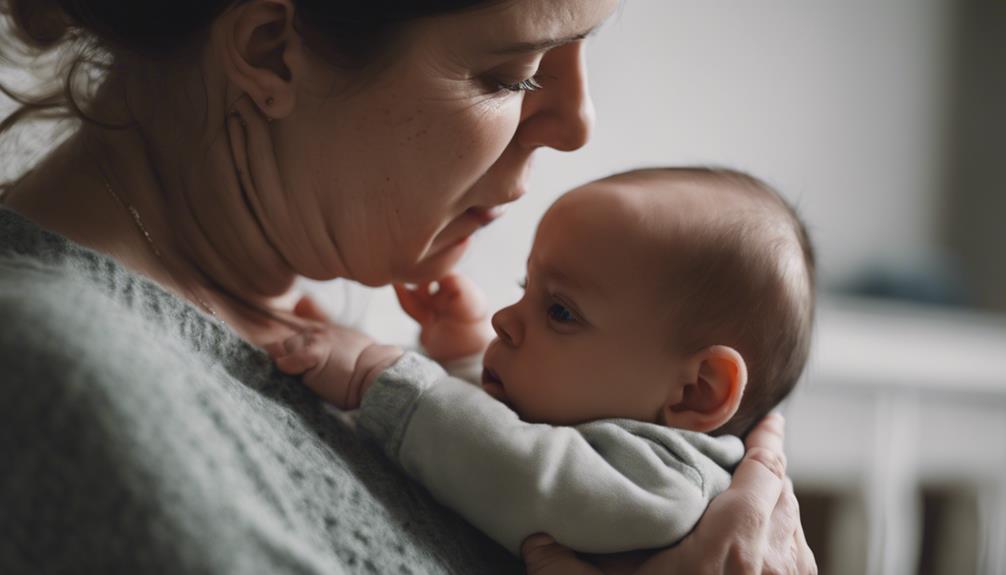
Attachment and excessive worry are fundamental components of separation anxiety disorder. Children with this condition may experience intense fear of abandonment, leading to persistent distress when separated from caregivers.
Understanding how to manage these separation worries is essential in helping children cope with their anxiety.
Attachment and Bonding
When children experience excessive worry about being apart from their caregivers, it can greatly impact their attachment and bonding relationships. Attachment refers to the emotional bond formed between a child and their primary caregiver, playing an important role in the child's development and sense of security.
In cases of separation anxiety disorder, this bond may become strained due to the child's heightened fears of separation. Factors such as genetic predispositions and environmental influences can contribute to the development of separation anxiety disorder, affecting how securely a child attaches to their caregivers.
Family members play a significant role in supporting a child with separation anxiety, offering understanding, patience, and reassurance during times of distress. By creating a supportive and nurturing environment, family members can help strengthen the attachment bond and alleviate the child's excessive worries about separation.
Understanding the impact of separation anxiety disorder on attachment and bonding can guide families in providing the necessary support and interventions to help children navigate their fears and develop healthier relationships.
Fear of Abandonment
Children with separation anxiety often struggle with a deep-seated fear of abandonment, which can manifest in various behaviors and emotions. This fear of abandonment stems from attachment issues and excessive worry about being left alone.
When faced with separations from caregivers, children with separation anxiety may exhibit clingy behavior, crying, and distress. Attachment to caregivers plays a significant role in the development of separation anxiety and fear of abandonment in children. The excessive worry about being abandoned or left alone can lead to heightened separation anxiety, making it challenging for children to cope with separations.
Understanding the root causes of separation anxiety, such as fear of abandonment and attachment issues, is vital in addressing and supporting children experiencing these challenges. By recognizing and addressing these underlying fears and worries, caregivers can help children navigate separation anxiety with patience and understanding.
Managing Separation Worries
Managing separation worries involves understanding the strong attachment children with separation anxiety have to caregivers and their excessive worry about being apart from them. While it's normal for young children to experience some level of separation anxiety when parents leave, persistent and overwhelming anxiety may indicate a separation anxiety disorder. This disorder typically emerges around 7 months of age and can continue into school years, affecting a small percentage of children, around 2-5%.
Genetic and environmental factors contribute to the development of separation anxiety disorder, especially if there's a family history of anxiety disorders.
Treatment options for separation anxiety disorder include family counseling, creating a supportive and less stressful environment, individual counseling for the child, and helping the child learn how to manage feelings of fear and worry.
Roots of the Disorder
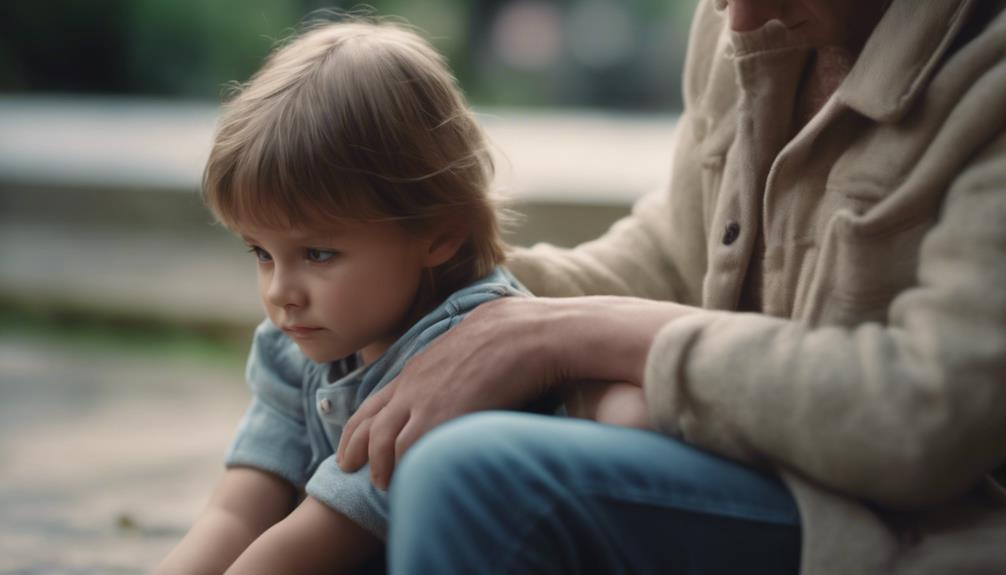
Early attachment experiences and fear of abandonment are key roots of separation anxiety disorder.
When children experience inconsistent caregiving or trauma during early developmental stages, it can contribute to the development of separation anxiety.
Fear of being left alone or abandoned by caregivers can intensify these feelings, leading to persistent and distressing symptoms of the disorder.
Early Attachment Experiences
An essential aspect in understanding the roots of separation anxiety disorder is the significance of early attachment experiences. Genetic and environmental factors play an important role in the development of this disorder, which affects around 2-5% of children.
Strong attachment bonds between children and caregivers are often present in cases of separation anxiety disorder. The onset of this disorder typically occurs between 7 months and school age, highlighting the importance of early experiences in shaping future behaviors.
Research suggests that children who've experienced inconsistent caregiving or disruptions in their early attachment relationships may be more susceptible to developing separation anxiety disorder. These early attachment experiences can impact how a child learns to trust others, regulate their emotions, and cope with separation from caregivers.
Understanding these early interactions can provide valuable insights into the roots of separation anxiety disorder and how it manifests in children. By recognizing the role of attachment experiences in this disorder, interventions can be tailored to address these foundational aspects and support healthy emotional development.
Fear of Abandonment
The fear of abandonment serves as a fundamental aspect underlying the roots of separation anxiety disorder in children. This fear can lead to children experiencing intense distress when separated from their caregivers, often exhibiting irrational fears of being left alone. Genetic and environmental factors play a significant role in the development of separation anxiety disorder, with a higher risk for children who have a family history of anxiety disorders. Statistics show that approximately 2-5% of children are affected by this disorder, highlighting the importance of understanding and addressing these concerns early on.
To better illustrate the impact of fear of abandonment on children with separation anxiety disorder, consider the following table:
| Aspects | Description |
|---|---|
| Symptoms | Irrational fears of separation from caregivers |
| Causes | Genetic predisposition and environmental influences |
| Prevalence | Affects around 2-5% of children |
| Risk Factors | Family history of anxiety disorders |
Genetic and Environmental Factors
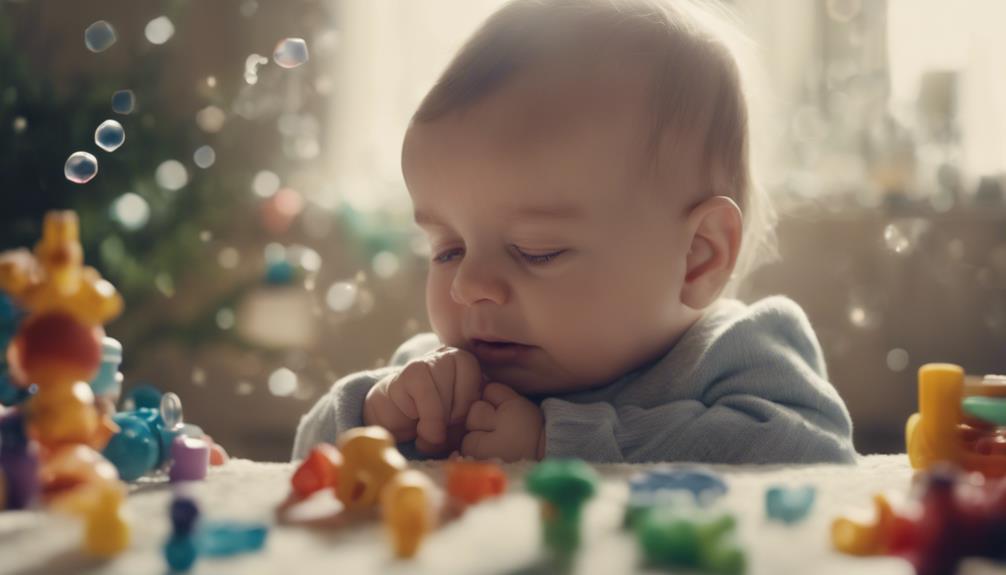
Genetic and environmental factors both play essential roles in the development of separation anxiety disorder.
Genetic factors, such as a family history of anxiety disorders, can increase the likelihood of a child experiencing separation anxiety. This genetic predisposition can heighten the risk of developing separation anxiety disorder when faced with situations involving separation from caregivers.
On the other hand, environmental factors like stressful events or significant life changes can also contribute to the onset of separation anxiety in children. These external factors can trigger and exacerbate the symptoms of separation anxiety disorder, leading to feelings of intense fear and distress when separated from loved ones.
Understanding the interplay between genetic and environmental influences is vital in comprehending the complexity of separation anxiety development. By recognizing these factors, caregivers and healthcare professionals can better support children affected by separation anxiety disorder and provide appropriate interventions to help them navigate through their fears.
Practical Advice for Families
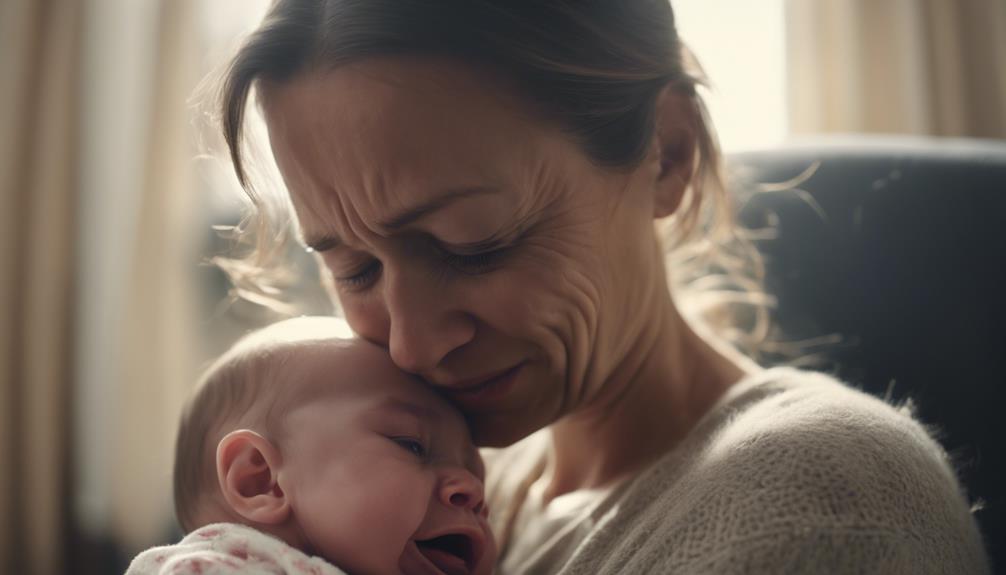
Understanding how to effectively manage separation anxiety in babies involves implementing practical strategies that can help families navigate through this challenging phase.
To help ease separation anxiety in babies and promote their independence, consider the following tips:
- Regular Cuddling: Providing physical comfort and reassurance through cuddling can help babies feel secure and connected to their caregivers.
- Brief Separations: Practice short separations from your baby to help them understand that you'll always return, building trust and security.
- Encouraging Safe Exploration: Allowing babies to explore their environment in a safe and supervised manner can boost their confidence and independence.
- Establishing Routines: A consistent routine provides predictability for babies, offering a sense of security and stability in their daily lives.
- Comforting the Child: Offering comfort and support when your baby shows signs of separation anxiety can help them feel safe and reassured during this challenging time.
Supporting Children Through Separation Anxiety

Guiding through separation anxiety with children involves implementing supportive strategies to help them cope with their emotions and fears. When children experience separation anxiety, it's important for the parent or caregiver to provide a sense of security and reassurance.
Spending quality time together as a family can help strengthen the bond and make separations easier for children and young people. Additionally, offering comfort and understanding during times of distress can greatly aid in alleviating separation anxiety.
Parents or caregivers play an essential role in supporting children through separation anxiety by being patient and empathetic. Taking the time to listen to their concerns and fears can make a world of difference. Creating a calm and nurturing environment at home can also help children feel more secure and less anxious about separations.
Coping Strategies for Children
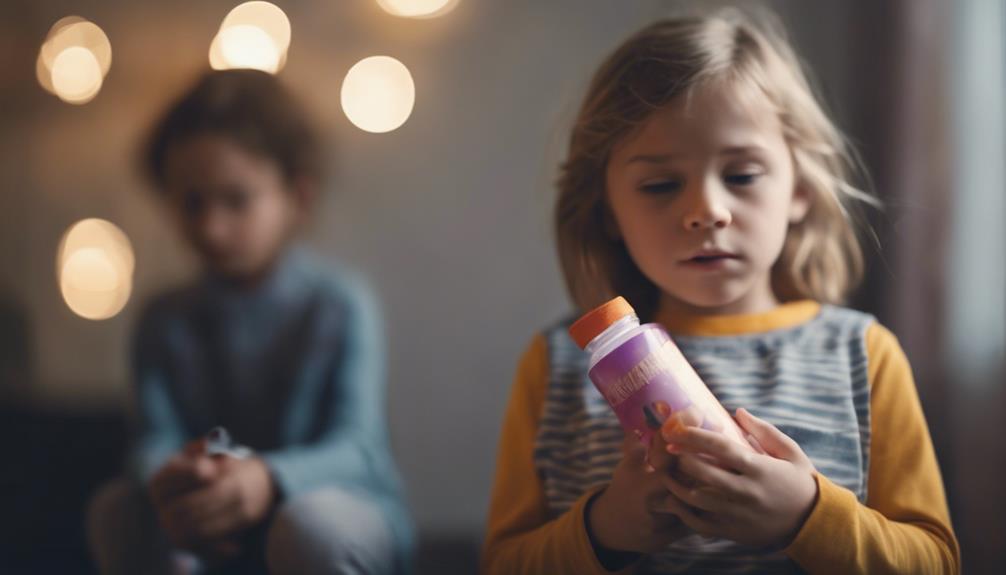
When helping children cope with separation anxiety, implementing specific strategies can greatly assist in managing their emotions and fears. Here are some effective coping strategies for children:
- Practice short separations: Building confidence in being apart from caregivers can help reduce separation anxiety.
- Encourage independence: Safe exploration and play can foster independence and decrease feelings of anxiety.
- Stick to consistent routines: Providing stability through consistent routines can ease separation anxiety in children.
- Offer comfort and reassurance: Showing comfort and providing reassurance during separations can help children feel secure.
- Seek professional help if needed: If separation anxiety is intense, prolonged, or interfering with daily activities, it may be beneficial to seek professional support.
Frequently Asked Questions
At What Age Do Babies Get Separation Anxiety?
Around 8 months, babies begin to show signs of separation anxiety. Toddlers might face separation challenges at 15-18 months, and preschoolers grasp its impact by age 3. Hungry, tired, or sick kids may find separations tougher. Consistency and routine help ease anxiety.
At What Age Does Separation Anxiety Typically Peak?
Around 8-10 months and again at 14-18 months, separation anxiety typically peaks. Toddlers may show more intense signs than babies. Factors like hunger or tiredness can worsen separations. Consistency, routine, and explanations help ease anxiety.
How Do You Respond to a Baby With Separation Anxiety?
When your baby shows separation anxiety, comfort them with reassurance and a consistent routine. Acknowledge their feelings and help them develop coping skills. Practice short separations gradually to help them adjust.
How to Help a Baby With Separation Anxiety Sleep?
You can soothe a baby with separation anxiety by sticking to a familiar routine, offering a security object for comfort, and engaging in calming bedtime rituals like reading or singing. Consistency and reassurance are key.
Conclusion
To sum up, understanding separation anxiety is key to supporting children through this common developmental phase.
Just like a caterpillar must leave its cocoon to become a butterfly, children must learn to navigate the world independently.
By recognizing the signs, providing reassurance, and implementing coping strategies, families can help their children overcome separation anxiety and thrive.
Remember, like a caterpillar transforming into a butterfly, children can emerge from this phase stronger and more resilient.






